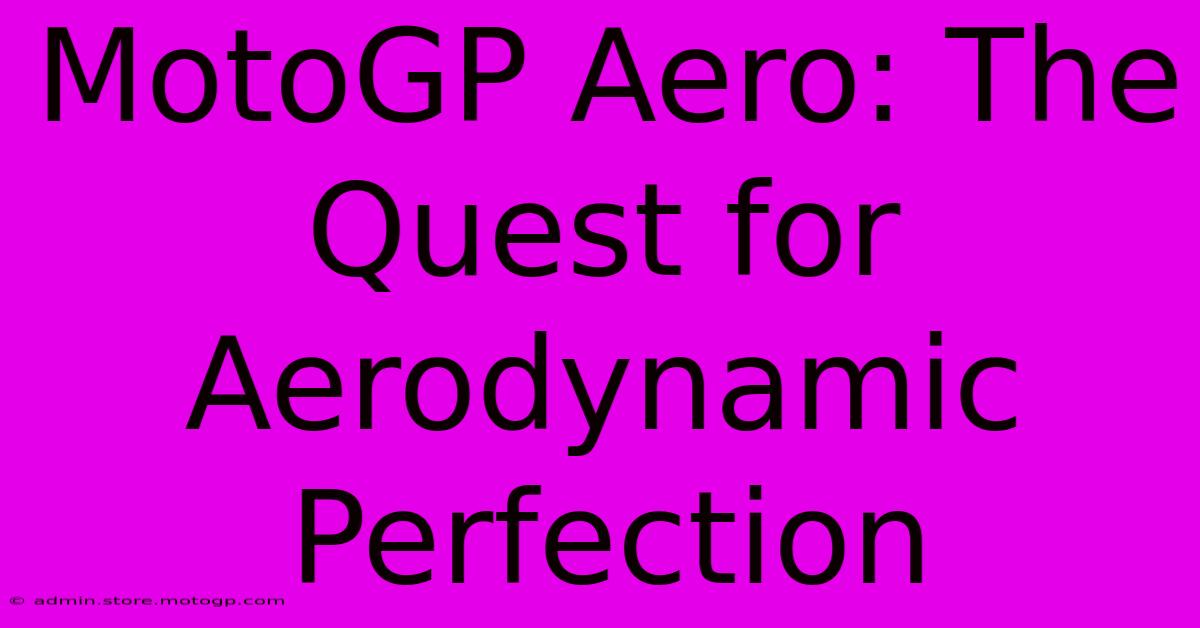MotoGP Aero: The Quest For Aerodynamic Perfection

Table of Contents
MotoGP Aero: The Quest for Aerodynamic Perfection
MotoGP, the pinnacle of motorcycle racing, is a relentless pursuit of speed and performance. Every millisecond counts, and in this high-stakes environment, even the smallest aerodynamic advantage can mean the difference between victory and defeat. This article delves into the fascinating world of MotoGP aero, exploring the constant quest for aerodynamic perfection that drives teams and manufacturers.
Understanding the Importance of Aerodynamics in MotoGP
Aerodynamics play a crucial role in MotoGP. At speeds exceeding 200 mph (320 km/h), air resistance becomes a significant force, dramatically impacting a bike's performance. Minimizing drag while maximizing downforce is the holy grail of MotoGP aerodynamic development.
Drag Reduction: The Pursuit of Speed
Drag, the resistance a bike encounters as it moves through the air, directly opposes forward motion. Reducing drag is paramount to achieving higher top speeds and improved acceleration. Teams employ various techniques, including:
- Streamlined fairings: The design of the bike's bodywork is meticulously crafted to minimize air turbulence and reduce drag. Every curve and angle is carefully considered.
- Winglets and aerodynamic appendages: These small, strategically placed components help to manage airflow around the bike, diverting it to reduce drag in critical areas.
- Lightweight materials: Using lighter materials, such as carbon fiber, reduces the overall weight of the bike, thus decreasing its inertia and improving its ability to overcome drag.
Downforce Generation: Enhanced Cornering and Stability
Downforce, the force that pushes the bike towards the track surface, is equally crucial. Generating sufficient downforce is essential for:
- Improved cornering speeds: Increased downforce allows riders to lean into corners at higher speeds without losing grip or control.
- Enhanced stability: Downforce keeps the bike planted on the track, improving stability at high speeds and under braking.
- Better braking performance: With more downforce, the bike is less prone to wheelies under heavy braking, allowing for more aggressive braking maneuvers.
The Evolution of MotoGP Aerodynamics
The evolution of MotoGP aerodynamics is a fascinating story of continuous innovation. From the relatively simple fairings of the past to the complex, multi-element wings of today, the changes reflect a relentless pursuit of performance.
The Rise of Winglets and Aerodynamic Devices
The introduction of winglets and other aerodynamic devices marked a significant turning point. These components dramatically improved downforce generation, allowing riders to push the limits of cornering speed. However, their use has also sparked debate regarding safety and the overall aesthetics of the sport.
Computational Fluid Dynamics (CFD): The Digital Wind Tunnel
Computational Fluid Dynamics (CFD) plays a vital role in modern MotoGP aero development. CFD simulations allow engineers to virtually test different designs, optimizing performance before physical prototypes are even built. This significantly speeds up the development process and reduces costs.
Wind Tunnel Testing: Validating Virtual Designs
While CFD is invaluable, wind tunnel testing remains crucial for validating virtual designs and fine-tuning performance. Sophisticated wind tunnels allow engineers to accurately measure aerodynamic forces and visualize airflow patterns around the bike.
The Future of MotoGP Aerodynamics
The quest for aerodynamic perfection is far from over. Future developments will likely involve:
- Further miniaturization of aerodynamic devices: The trend towards smaller, more efficient aerodynamic components will continue.
- Advanced materials and manufacturing techniques: The use of lighter, stronger, and more aerodynamically efficient materials will become increasingly important.
- Integration of AI and machine learning: AI and machine learning will play a growing role in optimizing aerodynamic designs and streamlining the development process.
Conclusion:
MotoGP aerodynamics is a complex and fascinating field, pushing the boundaries of engineering and design. The constant drive for aerodynamic perfection is a testament to the dedication and innovation that define this thrilling sport. The quest for those precious tenths of a second continues, making each race a captivating display of technological prowess and human skill.

Thank you for visiting our website wich cover about MotoGP Aero: The Quest For Aerodynamic Perfection. We hope the information provided has been useful to you. Feel free to contact us if you have any questions or need further assistance. See you next time and dont miss to bookmark.
Featured Posts
-
Moto2 Bikes Engineering Masterpieces
Feb 19, 2025
-
Unmatched Performance And Style Moto Gp Machine
Feb 19, 2025
-
F1 Qualifying Today A Fight For Pole Position
Feb 19, 2025
-
Moto Gp Qualifying The Grid Awaits
Feb 19, 2025
-
Moto Gp Commentary An Essential Part Of The Moto Gp Experience
Feb 19, 2025
